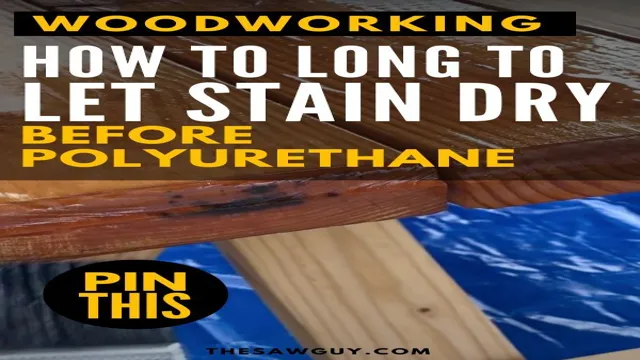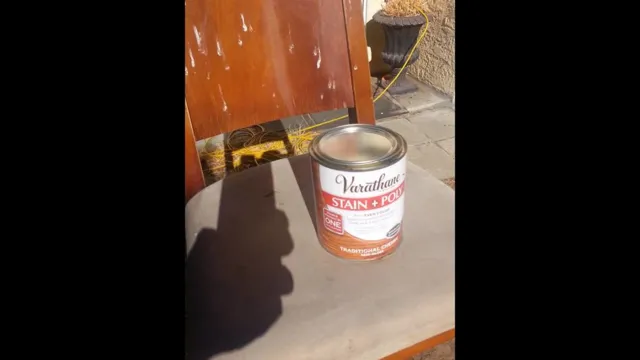Polyurethane and stains can be a match made in heaven, or a disaster waiting to happen. If you’re looking to add a layer of protection to your wooden furniture or flooring, polyurethane is a great choice. It’s durable, easy to apply, and provides a clear finish that won’t yellow over time.
However, when it comes to staining your wood before applying polyurethane, things can get tricky. There are certain do’s and don’ts you need to keep in mind if you want to achieve a beautiful, long-lasting finish. In this blog post, we’ll walk you through everything you need to know about polyurethane and stains, so you can get the most out of your woodwork projects.
What is polyurethane?
Polyurethane is a type of coating that is commonly used on wood surfaces to protect them from damage, wear, and tear. It’s essentially a plastic resin that creates a hard, durable finish on your wooden surfaces. However, it’s important to note that applying polyurethane before the stain is dry can cause a plethora of issues.
The main issue is that the polyurethane won’t adhere to the surface correctly, leading to a bumpy or uneven finish. Additionally, it could cause the stain to lift up and mix with the polyurethane, resulting in a discolored or mismatched appearance. Therefore, it’s important to wait until the stain is completely dry before applying polyurethane to ensure a smooth, even finish that will last for years to come.
So, it’s best to exercise patience and let the stain dry completely before applying polyurethane to your wood surfaces.
Definition and benefits of using polyurethane on wood finishes
Polyurethane is a popular finishing material used on wooden surfaces to improve their durability, shine, and resistance to environmental factors. It is a synthetic polymer that dries into a hard, plastic-like coating that can withstand abrasions, scratches, and water damage. Polyurethane is available in water-based and oil-based formulations, with the former being more environmentally-friendly and less toxic.
The benefits of using polyurethane on wood finishes include enhanced aesthetics, protection against wear and tear, longevity, and ease of maintenance. Additionally, polyurethane can provide a smooth, glossy or matte surface that highlights the natural beauty of the wood grain, making it an ideal choice for furniture, floors, cabinets, and other wooden objects. Overall, if you want to improve the lifespan and appeal of your wood products, polyurethane is a reliable and efficient solution.

Why wait for the stain to dry before applying polyurethane?
If you apply polyurethane before the stain on your wood is dry, you will experience a plethora of problems. First and foremost, the polyurethane will not adhere well to the surface and will eventually peel off over time, ruining all of your hard work. Additionally, if the stain is still wet beneath the polyurethane layer, it can become trapped and cause discoloration or blotching.
The best thing to do is to wait for the stain to dry completely before applying polyurethane. This ensures that the stain is properly absorbed into the wood and allows for a smoother application of the polyurethane. It’s important to follow the instructions on your stain and polyurethane products to ensure that you achieve the best possible results.
Don’t rush the process, take your time, and be patient. Your end result will be a beautiful and long-lasting project.
Moisture retention issues and product adhesion problems
If you’re wondering why you need to wait for the stain to dry before applying polyurethane, the answer is simple: moisture retention issues and product adhesion problems. When you apply polyurethane over wet or damp wood, it can trap moisture inside, leading to issues like peeling, blistering, and bubbling. This happens because polyurethane cures through a chemical reaction with moisture.
If it’s applied over wet wood, this reaction can take place prematurely, causing the polyurethane to dry before it has a chance to properly adhere to the surface. This leads to poor product adhesion, which can cause serious problems down the line. To avoid these issues, it’s best to wait until the stain has fully dried before applying polyurethane.
This will ensure that the surface is dry and ready for proper adhesion. So, if you’re tempted to cut corners and apply polyurethane over wet or damp wood, remember that waiting a bit longer will save you from costly and time-consuming repairs in the long run.
What happens if you apply polyurethane before stain is dry?
If you apply polyurethane before the stain is dry, your finished project may not turn out as you hoped. The polyurethane may trap the moisture from the wet stain, causing bubbles, peeling, and an uneven finish. Additionally, the polyurethane may not adhere well to the wet stain, leading to a patchy appearance and a weak bond between the layers.
It’s important to allow the stain to fully dry before applying the polyurethane to ensure a smooth and even finish. To avoid this mistake, make sure to follow the manufacturer’s instructions for the drying time of both the stain and polyurethane, and test the surface before applying the topcoat. A good rule of thumb is to wait at least 24 hours before applying polyurethane over a stain.
Taking time to prepare and properly apply your finishing products will ensure a beautiful and long-lasting piece that you can be proud of.
Effects of premature polyurethane application and how it affects your stained wood finish
If you apply polyurethane before your stain is fully dry, it can have some serious effects on your wood finish. The first thing you may notice is that the finish may appear hazy or cloudy, which can be very frustrating. This is because polyurethane creates a chemical reaction with the stain, causing it to become trapped in the finish and not allowing it to properly dry.
Additionally, the polyurethane may not adhere properly to the wood, leaving bubbles, peeling, and other kinds of unsightly issues. You may think that applying another coat of polyurethane will solve the issue, but this will only make the problem worse. If you find yourself in this situation, the best thing to do is to lightly sand the affected area and allow it to fully dry before applying another coat of polyurethane.
Remember, patience is key when it comes to staining and finishing wood!
Remedying mistakenly applied polyurethane on an unfinished or partially dry surface
If you apply polyurethane before the stain is completely dry or on an unfinished surface, you may experience some issues that will need to be remedied. One issue that can arise is an uneven finish due to the polyurethane not adhering properly to the surface. Another issue is the stain or wood expanding, causing bubbling or peeling of the topcoat.
However, don’t panic, as there are a few methods to remedy the situation. First, wait for the surface to dry completely before sanding it down to remove any bubbles or uneven areas. Then, reapply the stain and let it dry completely before applying the polyurethane.
Another method involves using a mineral spirit or a chemical stripper to remove the polyurethane, sanding down the surface to remove any excess stain, and then reapplying the stain and waiting for it to dry before applying the topcoat. Remember to always follow the manufacturer’s instructions for both the stain and polyurethane to avoid these issues in the first place.
Step-by-step guide on how to fix and avoid future issues with stained finishes
If you’ve mistakenly applied polyurethane to an unfinished or partially dry surface, you’re not alone. It can be a common mistake, but it’s important to know how to fix it properly to avoid future issues with stained finishes. Here’s a step-by-step guide on what to do.
First, stop working on the surface immediately. Next, sand the surface thoroughly to remove the layer of polyurethane. Use a fine grit sandpaper and ensure all areas are sanded evenly.
After sanding, wipe the surface clean with a damp cloth to remove any dust or debris. Allow the surface to dry completely before applying a new coat of stain or finish. To avoid this mistake in the future, always ensure that the surface is completely dry before applying any stains or finishes.
Additionally, make sure to follow the manufacturer’s instructions carefully and evenly apply the product. With these simple steps, you can get back to creating beautiful finishes without any issues!
Conclusion
In conclusion, applying polyurethane before stain is dry may lead to a sticky situation. It’s like trying to put on makeup before your moisturizer has fully absorbed – it just won’t work out in your favor. Trust the process and allow your stain to dry completely before adding the final coat of polyurethane for a smooth and successful finish.
Remember, patience is a virtue in the world of woodworking.”
Best practices to achieve excellent results with wood finishes
When it comes to wood finishes, mistakes can happen. One common issue is mistakenly applying polyurethane to an unfinished or partially dry surface. Fortunately, there are ways to remedy this situation.
For a partially dry surface, gently sand off the polyurethane with a fine-grit sandpaper and then allow the surface to fully dry before applying a new coat. If the surface is completely unfinished, use a paint stripper to remove the polyurethane and then sand the surface to achieve a smooth and even finish. It’s always essential to follow best practices when working with wood finishes, including thoroughly sanding and cleaning the surface before application, using high-quality materials, and taking your time to apply coats evenly.
By doing so, you can achieve excellent results that will enhance the natural beauty of the wood and provide lasting protection.
FAQs
Can I apply polyurethane before the stain is dry?
It is not recommended to apply polyurethane before the stain is completely dry, as it can cause the stain to smear or lift.
What happens if I apply polyurethane before the stain is dry?
If you apply polyurethane before the stain is fully dry, the stain can become trapped under the finish and cause the final result to look uneven or blotchy.
How long should I wait before applying polyurethane after staining?
It is best to wait at least 24 hours after staining before applying polyurethane to ensure that the stain has fully dried.
Can I use a fast-drying polyurethane if my stain isn’t dry?
Using a fast-drying polyurethane may not solve the problem of applying before the stain is dry, as it can still trap the wet stain underneath and cause issues with the final result.
Is it necessary to sand between coats of polyurethane if the stain is already dry?
Yes, sanding between coats of polyurethane helps to ensure a smooth and even finish, regardless of whether or not the stain underneath is dry.
How many coats of polyurethane should I apply over stained wood?
The number of coats of polyurethane needed depends on the desired level of protection and the type of wood being used. Typically, 2-3 coats are recommended.
Can I apply a second coat of polyurethane the same day?
It is possible to apply a second coat of polyurethane the same day, but it is best to wait at least 2-4 hours between coats to ensure proper drying and adhesion.






